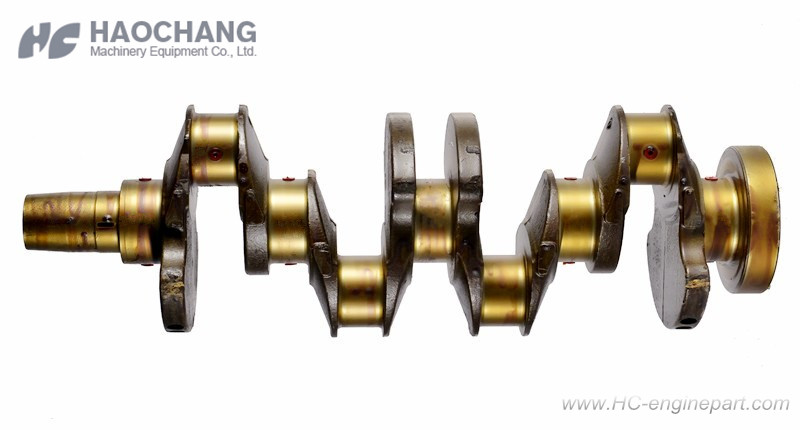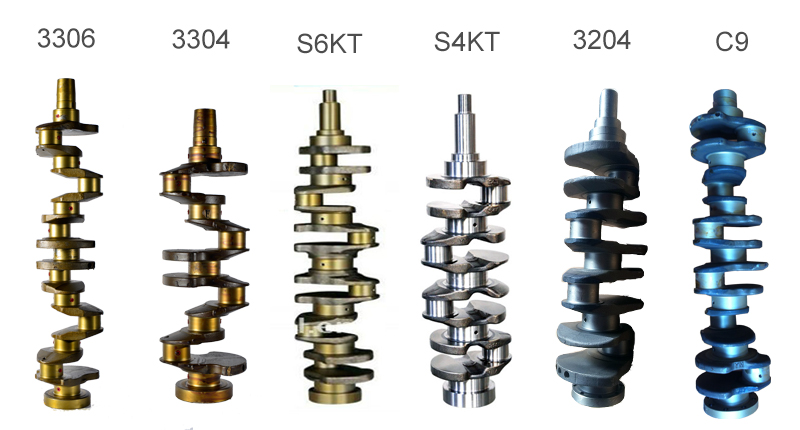1. The weight of the piston connecting rod has a certain influence on the arm distance difference, especially for large low-speed diesel engines.
The law of the influence of the weight of the piston connecting rod on the arm distance difference is generally: when the weight of each main shaft is uniform and the main journal and the lower bearing bush are attached well, remove the piston connecting rod. If the original arm distance difference is positive , The positive value decreases and approaches zero or a negative value, so that the crankshaft axis tends to bend in the upward supply direction. For small and medium-sized diesel engines, due to the lighter weight of the piston connecting rod and the high rigidity of the crankshaft, there is no obvious influence on the crankshaft arm distance before and after the piston connecting rod is removed, generally not exceeding 0.03mm.
2. The influence of ship loading conditions on crankshaft arm distance difference.
This is due to the uneven distribution of the buoyancy and loading weight on the hull, which makes it elastically bent and deformed, which affects the deformation of the machine base and changes the crankshaft arm distance difference. For the midship engine room, when the cargo is concentrated on the bow and stern ends of the ship, it will cause the middle of the hull to bend upwards, which causes the crankshaft axis to also bend upwards. Since the installation and repair of the crankshaft are usually carried out when the ship is empty, full attention must be paid to the loading situation. When positioning the base, it is best to make the crankshaft arm distance difference positive (even if the axis is concave). In this way, when the ship is heavily loaded, the hull will have a convex shape, so that the crankshaft axis is approximately straight. This method is not only suitable for the midship engine room, but also for the stern engine room. In addition, although the ship's ballast, fresh water and oil have the same impact on the arm distance difference as the loading, because the impact is not large, it is often ignored and not calculated.
3. The influence of uneven wear of the main bearing on the crankshaft arm distance difference.
When one or more of the main bearings are worn out, the main journal will sink unevenly, which will change the crankshaft arm distance difference. The uneven wear of the main bearing is mainly caused by the unevenness of the cylinders in use, the poor assembly of the main bearing, the failure of the lubrication system, the poor quality of the lubricating oil, or the poor quality of the wear-resistant alloy of individual bearings.
4. The influence of the cooling state of the diesel engine on the crankshaft arm gap.
The cold state of a diesel engine refers to the state where its own temperature is the same as the ambient temperature, and the hot state refers to the temperature state of the diesel engine after a period of operation. Under the same conditions of other conditions, the measured arm distance difference between the cold state and the hot state of the diesel engine is different. The general rule is: the measurement in the hot state will increase the arm distance difference in the direction of negative value than the measurement in the cold state. . If the arm gap difference is negative in the cold state, the negative value increases in the hot state; if the arm gap difference is positive in the cold state, the positive value decreases and tends to zero or negative in the hot state. In the hot state, the crankshaft axis bends in the upward arch direction.
5. The influence of flywheel weight on crankshaft arm distance difference.
After the flywheel is installed, the arm distance difference of the crank near the end of the flywheel is increased in the direction of negative value or decreased in the direction of positive value, and the crankshaft axis tends to arch upward. The influence of the weight of the flywheel will involve the arm distance difference of the second crank from the end of the flywheel. This is due to the fact that the upper arch of the crankshaft is deformed and the bearing is separated from the bearing. Its axis is the same as that of the crank near the end of the flywheel, but the degree of influence is slight.
6. The influence of the tightness of the bottom corner bolts or through bolts on the crankshaft arm distance difference.
After the diesel engine runs for a period of time, some anchor bolts and through bolts will loosen. Affect the normal operation of diesel engines. It is possible that the condition of the machine base will change, which will change the crankshaft arm distance difference. When the diesel engine is being repaired, before the crankshaft centerline inspection, first check whether the anchor bolts are loose, and whether the cushion blocks between the engine seat and the hull foundation are loose. When checking, use a small hammer to lightly hit the pad. If there is a loud sound when tapping, it means that the contact is good. The tightening of the through bolts must be carried out in strict accordance with the methods and requirements specified in the instruction manual. The left and right sides must be tightened at the same time, and the bolts must be tightened from the middle to the two sides in two times.
After comprehensively analyzing the various factors that affect the crank arm distance difference, it can be concluded that “the crank arm distance difference is a value under certain conditions, and is a relative value. When the conditions change, the value of the arm distance difference is also To change". Therefore, when analyzing the arm distance difference, you should first understand the measurement conditions, and then compare them under roughly the same conditions, otherwise it will be meaningless. After the crankshaft is equipped with the flywheel and the piston connecting rod, if the main bearings are coaxial, the crank arm distance difference may not be all zero; on the contrary, if the crank arm distance difference is all zero, it does not mean that the main bearings are Must be coaxial. It can not be generally considered that the best assembly quality is when the crank arm distance difference is adjusted to zero.

